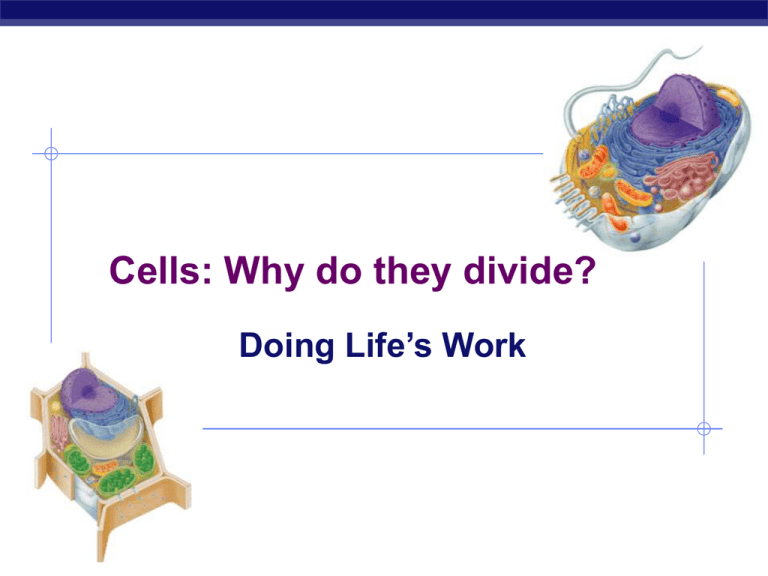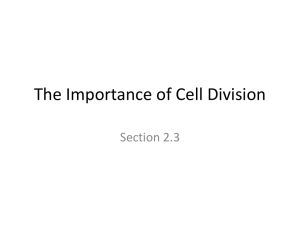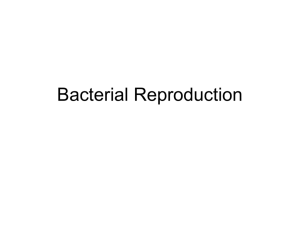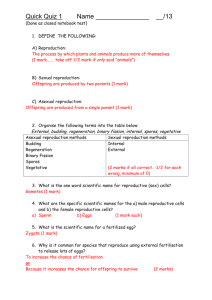Cells: Why do they divide? Doing Life’s Work
advertisement

Cells: Why do they divide? Doing Life’s Work Types of cells bacteria cells Prokaryote -no organelles -no nucleus Eukaryotes -Organelles -nucleus animal cells plant cells Cell size comparison most bacteria Animal cell Bacterial cell 1-10 microns eukaryotic cells 10-100 microns micron = micrometer = 1/1,000,000 meter diameter of human hair = ~20 microns Why study cells? Cells Tissues Organs Bodies bodies are made up of cells cells do all the work of life! The Work of Life What jobs do cells have to do for an organism to live… “breathe” O2 in vs. CO2 out ATP Eat make energy build molecules remove wastes control internal conditions respond to external environment build more cells growth, repair, reproduction & development The Jobs of Cells Cells have 3 main jobs make energy need energy for all activities ATP need to clean up waste produced while making energy Our organelles do all these jobs! make proteins proteins do all the work in a cell, so we need lots of them make more cells for growth to replace damaged or diseased cells Making more cells is OUR focus Think about it… why do we need to make more? Before we get too far... What limits cell size? How do you think the size of the cell affects the distribution of chemicals throughout the cell? Write your hypothesis to this question: If… then____ Modelling Limits to cell size We will use different sized agar cubes as models of living cells. You will submerge them in a NaOH solution for 10 min. and observe whether it diffuses to the centre We will investigate a relationship between the surface area and the volume of different sized cells, and drawing conclusions about maximum size I need a volunteer! Measure the three cubes, and record the values on the blackboard Cube Small Medium Large Everyone needs to copy this table down, and calculate the first 3 columns while we wait Surface area (cm2) Volume (cm3) SA/Volume ratio Diffusion Depth (mm) Diffusion Rate (mm/min) Analysis: Answer in your notes: 1. What does the colour change in the cells indicate about the diffusion of NaOH? 2. Did all the cells change colour all the way through? 3. Calculate the diffusion rate per min for each cell, and record it in your table 4. Compare the results to your hypothesis. Was your prediction correct? 5. If the coloured part of the cell is thought of as the part that gets a lot of food and oxygen, and can get rid of wastes by diffusion, which of the three cells is best able to carry out these functions? Explain Analysis 6. If all cell activity takes place in the cell’s interior, but all materials enter and exit through the cells surface, explain the importance of the surface area to volume ratio. 7. So... Why do cells divide!? 8. How might temperature affect the results of this activity? How would this relate to your cells? Back to our focus: Cells gotta work to live! They need to make more cells growth repair reproduction To reproduce, repair & grow, the cell must… copy their DNA make extra organelles divide the new DNA & new organelles between 2 new “daughter” cells Cell Division for Growth: Main characteristic of living things is to grow As you grow, the number of cells increase Chemical signals cannot get across a cell efficiently if they are too large, so they must divide Cell Division for Repair: Dead/ injured cells Your body sheds millions of cells daily! All of which need to be replaced Broken bones, blisters, cuts, you need new cells to heal the break Cell lifespans Not all cells are created equal, they all have a predetermined self-destruct time! red blood cells live 120 days liver cells live 200 days intestine lining cells live 3 days skin cells live 20 days stomach lining cells live 2 days brain cells live 30-50 years Cell Division for: REPRODUCTION Important characteristic for ‘living’ things Asexual reproduction: involves only one parent, and the offspring all have identical DNA to the parent and eachother Occurs in many single celled organisms, and ALL your body cells excluding sex cells REPRODUCTION Sexual Reproduction: sex cells/gametes (which contain only half of the necessary DNA) from two parents join to create offspring with characteristics from both parents Offspring are not identical Some Questions… For you to answer: 1. A cleaning product claims to kill 99.9% of all 2. 3. 4. 5. bacteria. Will a cleaned surface stay bacteria free forever? Explain your reasoning. What is the major difference between sexual and asexual reproduction? Why do cells divide instead of just getting bigger as organisms grow? Provide some evidence that suggest that not all cells in your body divide at the same rate (speed). At one time, Dr.’s transfused blood from younger individuals into the elderly. They believe that the younger blood would provide the elderly with more energy. Do older people have older blood? And some research for homework: 6. Why might scientists want to get mature nerve cells to divide? [Read this, it might help! – Brain cells are not just precious, they are irreplaceable. Although we each have many billions of neurons, as they are known, we cannot make any more to replace those that die. During development, neurons lose the capacity to divide to make new cells or even grow the processes that form circuits in the brain. Scientists are trying to discover how to restore these capacities in order to treat degenerative diseases of the brain.] Find a brain cell (a.k.a. neuron) on the internet and print it out. Explain in 1 paragraph how brain cells communicate with one another.








